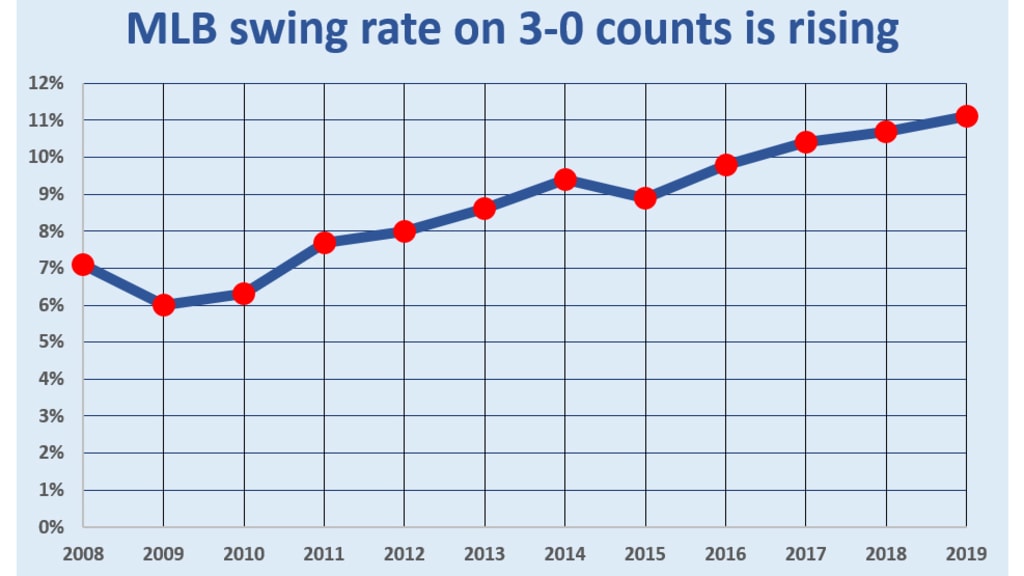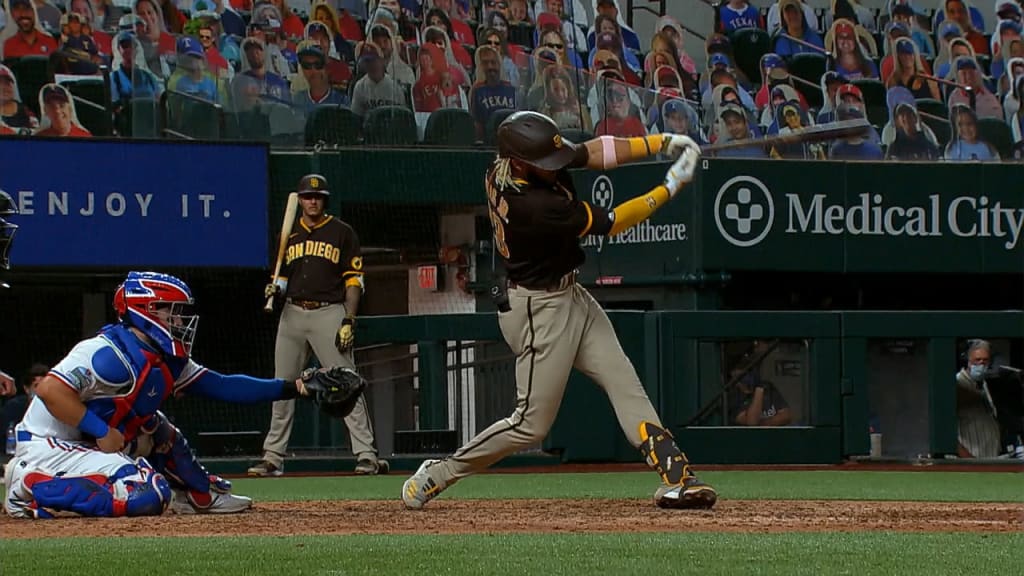3-0 swings rising for opportunistic hitters
This browser does not support the video element.
When Padres phenom Fernando Tatis Jr. mashed a grand slam on a 3-0 pitch in a game against the Rangers on Monday night -- extending his team’s seven-run lead in the eighth inning -- it set off baseball’s latest debate over the unwritten rules.
Some, including the Rangers, took exception to Tatis cutting loose with a 3-0 count in that situation. Many others around the game rushed to the young shortstop’s defense.
Whatever your feelings about it, this much is certain: Things are changing when it comes to how players approach 3-0 counts. Attitudes are evolving. Behavior is shifting.
Here is a look at what hitters are doing in 3-0 situations, why taking remains the overwhelming choice and why swinging more often could pay huge dividends.
Are hitters swinging more on 3-0?
To put it simply, yes. Tatis’ slam was not an aberration, nor was Mike Trout launching the first 3-0 homer of his career last month. Big league hitters have been gradually getting more and more aggressive in 3-0 counts.
In 2008, the first year of the pitch-tracking era, Major League hitters swung at 7.1% of 3-0 offerings, not counting intentional walks. The rate dropped the next year, but then rose in nine of the next 10 seasons, from 2010-19. It reached a high of 11.1% last year.

The rate is down a bit in 2020, to 10%. But that’s in less than a month’s worth of data, and the overall swing rate this season is the lowest since 2010, with hitters perhaps easing their way into a delayed, out-of-the-ordinary season. Since Aug. 10, the 3-0 swing rate is up to 11.9%.
And while Trout is notoriously choosy on 3-0, some stars are far more aggressive. In the past three seasons, Pete Alonso, Ronald Acuña Jr., Aaron Judge, Freddie Freeman and Giancarlo Stanton are among those with 3-0 swing rates above 30%.
Why are 3-0 takes still so widespread?
The game situation and that oh-so-sacred unwritten rulebook undoubtedly still push hitters to take on 3-0 in some instances. But even setting those considerations aside, there are purely strategic reasons to keep the bat on your shoulder
The pitcher has just thrown three straight balls to begin a plate appearance, and now he has to throw at least three strikes before missing again in order to avoid a walk. If a hitter simply takes, he has a good chance to reach base, which is the fundamental goal of any plate appearance.
In 2019, after jumping ahead in the count 3-0, Major League hitters posted an on-base percentage of .710 (not counting automatic walks). Roughly 59% of those plate appearances ended with a walk, with the majority of those free passes coming on the 3-0 pitch itself.
This browser does not support the video element.
Even in the 63% of 3-0 takes that resulted in a called strike in 2019, the batter was still in control. The league as a whole slugged .713 in 3-1 counts, and after reaching that point in a plate appearance, the collective OPS was still 1.082 -- almost exactly what Trout produced.
Given all that, a 3-0 take makes plenty of sense, especially for a weaker hitter or one without strong strike zone judgment. “Trying to do too much,” is a baseball cliche, but it’s a real concern in these situations.
“Sometimes guys try to hit the ball harder or farther, they go outside the zone and they make an out,” then-Angels manager and longtime MLB player Brad Ausmus told the Los Angeles Times last year, regarding 3-0 counts. “You have to get the ball in your sweet spot and only swing in that zone.”
Why should hitters swing on 3-0 more?
Hitters today have their hands full. Every year, fastballs get faster, yet pitchers throw more and more breaking balls -- many of them appearing to strain the laws of physics. Meanwhile, starters continue to see their workloads shrink, with batters now facing an endless stream of relievers with absurd stuff. Peruse the Twitter feed of the Pitching Ninja on any given night, and you’ll wonder how anyone ever gets a hit.
In that context, why wouldn’t a hitter take advantage of any slim opportunity to jump on a juicy pitch? As A’s All-Star third baseman Matt Chapman explained recently, via Sports Illustrated, it was likely that the 3-0 pitch Tatis swung at -- a fastball in the zone -- was going to be the best pitch he saw in that plate appearance.
“If you take that 3-0 pitch, then you’re 3-1 and you probably get a 3-1 slider,” Chapman said. “And then you’re at 3-2 and you probably get a 3-2 changeup, and there’s no telling what happens.”
Hitters see their highest rate of pitches in the strike zone in 3-0 counts (60.9% in 2019) and by far their highest rate of fastballs (95.9%). But we can be more precise here by zeroing in on the pitches that truly make a hitter’s eyes light up with excitement.
In 2019, Major Leaguers posted a .328 average and .605 slugging percentage on fastballs in the “heart” of the strike zone, compared with .252/.435 overall, and just .223/.381 on all breaking balls and offspeed pitches. (The “heart” focuses on pitches at least one baseball’s width inside the edge of the strike zone, eliminating borderline pitches that often work in a pitcher’s favor).
What % of pitches are fastballs in the heart of the zone?
All MLB hitters in 2019
On 3-0: 34.2%
On 3-1: 28.2%
On 2-0: 24.4%
On 3-2: 22.1%
On 2-1: 19.6%
On 1-0: 18.7%
On 0-0: 18.5%
On 2-2: 14.1%
On 1-1: 14.9%
On 0-1: 13.0%
On 1-2: 10.2%
On 0-2: 8.8%
This browser does not support the video element.
When players swung at these types of pitches on 3-0 last year, they produced an extra-base hit 13% of the time. That might not sound like much, but keep in mind that only 4.7% of all swings generated such a favorable outcome.
It’s no wonder that MLB saw at least an .820 slugging percentage in 3-0 counts in each of the previous four seasons (up to a gaudy 1.128 this season, through Thursday). By comparison, hitters have slugged .559 during that stretch in all other counts, even removing strikeouts from the equation to level the playing field.
As Chapman noted -- as did Hall of Famer Johnny Bench -- if a hitter lets a golden opportunity pass by on 3-0, there is a good chance he will not see another one. And while outcomes are still excellent in 3-1 counts, once a plate appearance gets to 3-2, the balance of power turns. Batters still draw lots of walks (.453 OBP in 2019), but they do little damage (.202 BA / .362 SLG) and strike out nearly 28% of the time.
“Sometimes you’ll get a pitcher who is really tough once they get you to two strikes, so if you got a 3-0 count, you maybe want to be aggressive there because that could be the best pitch,” Royals manager Mike Matheny said recently. “You don’t want to get to 3-2.”
This browser does not support the video element.
Will we reach a tipping point?
The cat-and-mouse game between hitters and pitchers sits at the heart of the sport, and it never ends. One side evolves. The other side adjusts. The first side searches for a new tactic.
Behavior in 3-0 counts doesn’t figure to be any different.
If the swing rate on 3-0 continues to rise -- and there’s no reason to think it won’t -- then it follows that pitchers will react accordingly. What’s now almost an automatic fastball might give way to greater pitch-type variety. That laser focus on the center of the zone might disperse. Hitters no longer will be able to gear up for a meaty pitch with quite the same confidence. Walks may increase, but damage may decrease, with hitters more frequently paying for being overeager.
As veteran pitcher Collin McHugh put it on Twitter when discussing the Tatis situation, “In this data-driven baseball age, there’s nowhere to hide. If you have a tendency, it’s gonna be exploited.”
The countermove has not happened yet, at least on a league-wide scale. Pitchers are throwing those heart-of-the-zone fastballs just as often on 3-0 now -- if not more often -- than they have throughout the 13 seasons of the pitch-tracking era.
But as attitudes across baseball progress and attachment to the unwritten rules fade, it could only serve to hasten the transformation of the 3-0 count from passive to action packed.
